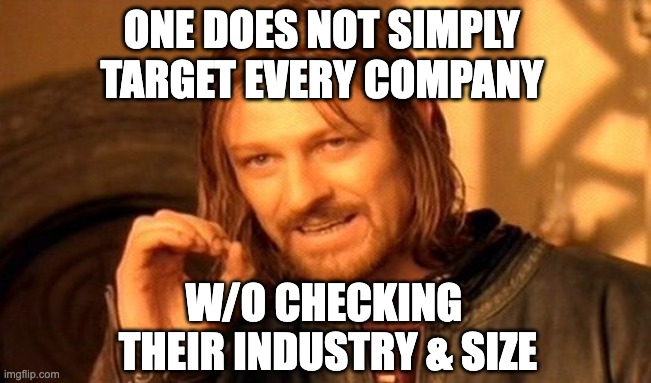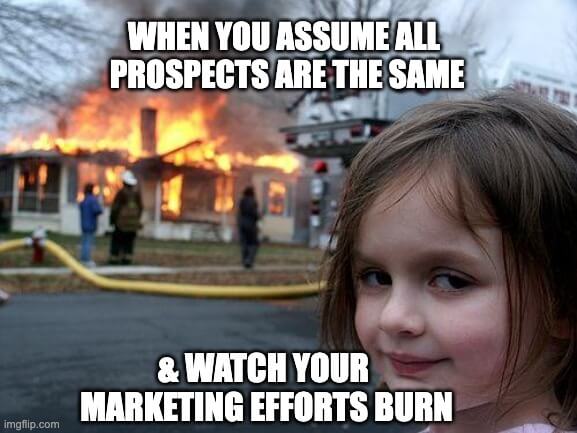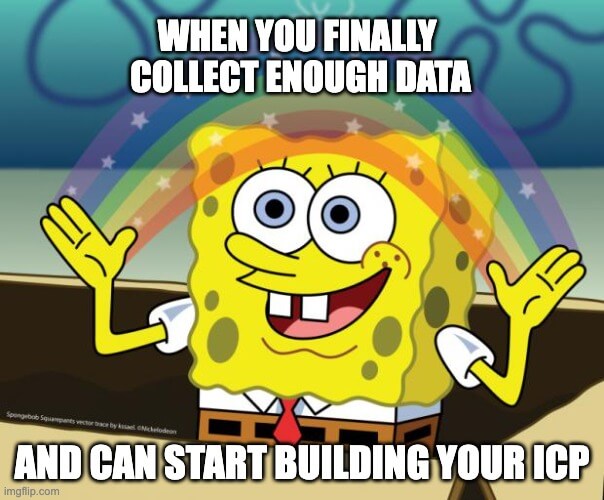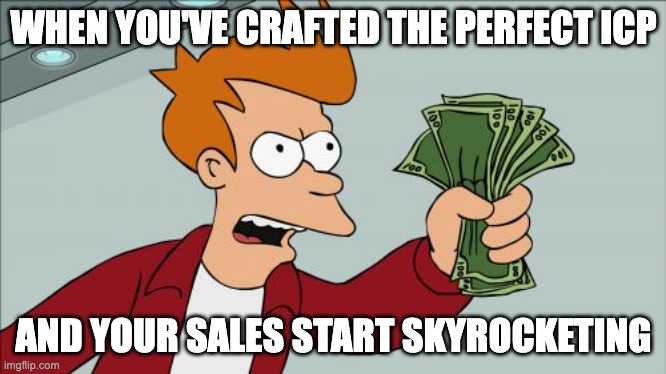Many years ago when my wife was still in college, she attended a motivational seminar.
She didn’t go to the seminar because she’s into self-development. She was “forced” to go there because it’s a requirement to pass a class she took. “Stupid requirement,” she’d say.
Throughout the seminar she was bored to death.
The funny thing is… if it were me attending the seminar, I’d even gladly pay for it! Heck, the speaker was the country’s #1 motivator. And at that age, I’m all into motivational seminars.
Ideal Client Profile (ICP) Explained
This is the power of an Ideal Client Profile.
The same event. 2 totally different outcomes. One would’ve loved it, the other clearly not enjoying.
You can think of Ideal Client Profile (ICP) as the perfect client / customer for your business. “Perfect” here means those who’d enjoy your product / service the most. In the example above, I’d be an ICP for the motivational seminar.

After this blog post, you’d have a deeper understanding of what an ICP is and how to craft one… so that you’ll craft more enticing marketing campaigns — ultimately getting more sales.
As I’ve briefly explained above, an Ideal Client Profile is a description of your perfect customer or client. It’s the person or company that gets the most value out of what you’re selling.
You want to think about demographics:
Who they are
What they need
Their behavior

If you’re a business, you’ll want to look at things like company size and what industry they’re in. We call those firmographics and they help you narrow down the right companies to target.
Then there’s technographics — basically knowing how they use technology in their business. This info will come in handy when you create marketing campaigns.
Why Does My business Need an Ideal Customer Profile?
No matter if you sell to consumers or other businesses, a clear ICP will help you get more customers at a lower cost (cheaper customer acquisition cost)because your marketing message is on-point.
Also understand that your ICP can and will change as your business evolves and grows.
If you don’t have an ICP, you’re likely wasting money on marketing to the wrong prospects. What you don’t want is a profile that’s too general, trying to market to everyone.
What’s a Buyer Persona?
Understanding your Ideal Client Profile and Buyer Persona is important for customer profiling.
An ICP describes the characteristics of the companies your ideal clients come from.
A Buyer Persona is a semi-fictional representation of your ideal client based on research and data.
How Are They Different?
An ICP focuses on company characteristics like industry, size, revenue, technology use, and more. A Buyer Persona looks at the motivations, pain points, and communication preferences of individual decision makers.
Personalizing your marketing helps ideal customers feel understood and appreciated. When you understand their priorities, you can speak directly to their needs.

Customer profiles segment your prospects into groups with similar needs and characteristics. Assuming all prospects are the same is dangerous and ignoring unique client characteristics is a recipe for disaster.
Regularly updating your profiles is important to remain relevant in a changing market.
What Are the Benefits of Using Both?
Using both ICPs and Buyer Personas can increase your close rates, help you build stronger relationships with clients, and create more effective marketing. ICPs help you identify better-fit prospects to increase customer satisfaction. Buyer Personas help you create targeted marketing by understanding your clients’ priorities and needs.
Customizing your approach helps you connect with your ideal clients on a deeper level and build more meaningful relationships.
How Do I Create an Ideal Client Profile?
Creating an Ideal Client Profile is an ongoing process. With time, you’ll become more specific and targeted in your marketing and sales efforts. Follow these 6 steps to create a good customer profile.
Examples of ideal client profiles can help inspire you as you create your own.
Step 1: Collect Existing Customers’ Data

Gathering customer and client data is super important. Because when you gather enough of their data and feedback, you can categorize their preferences, wants, needs, desires, problems, etc. to find the overlapping ones. These are usually what you should focus on.
Start by asking your customers questions and actively listening to their responses. Surveys, interviews, or just plain-old simple conversations can provide valuable insights into how to improve your product…
Or even come up with a new offer.
An additional benefit when you actively listen and engage even after they’ve handed their money to you is that they feel you want the best for them. Many companies are never to be seen after the customers have bought. So just by doing this, you stand out from the crowd and build trusting relationships with them. The result is increased customer loyalty.
Step 2: Know Their Demographics

Age and gender
Marital status
Location
Education
Income
Job title and career level
Also consider these:
Company size
Number of employees
It’s also important to understand the value of each customer to your business. Are they high or low maintenance? Do they require special handling?
Step 3: Understand Customers’ Pain Points
Understanding your customers’ challenges and motivations is important for creating effective client profiles. Pain points drive purchasing decisions, so it’s important to understand what theirs are.
Analyzing customer reviews can help you identify themes and patterns in their motivations, challenges, and behavior that point to their pain points.
Create Customer Journey Maps
Customer journey maps visualize the entire process customers go through when interacting with your brand to purchase from you.
Touch points
When you map your touch points, you can see where you’re falling short and causing your customers pain. Customer feedback is important for understanding their challenges and pain points.
Improving The Customer Experience
Customer journey maps help you see where you can improve your service and how you can engage with your customers better. By analyzing each touchpoint, you can create a strategy to enhance your service.
An ICP helps you understand your clients’ pain points and needs, which improves customer retention and satisfaction.
Segment Your Market
A customer profile is a detailed description of your ideal client. It helps you target your marketing to the right leads, personalize your messaging, and increase revenue. A good customer profile is important because it helps you create more effective marketing, sales, and service efforts.
Marketing segmentation is the practice of grouping your customers into categories so you can target them more effectively. Understanding your customer segments helps you anticipate their needs and meet varying requirements.
Behavioral segments focus on how customers interact with your products or services. This information helps you create targeted marketing by understanding how they use what you offer.
Segmented customer profiles help your marketing team create campaigns that resonate with each group. Refreshing your customer profiles regularly is important to remain relevant in a changing market.

Once you have your customer profiles, it’s important to share them with your entire team. Your sales, marketing, and customer service teams need to understand your ideal clients and their needs to effectively attract and retain them.
Your customer profile should be shared with your marketing team, sales team, and customer service team. This helps your entire business understand your ideal clients and their needs, hence providing excellent customer service.
Examples of Ideal Client Profiles (ICPs)
There are many formats and styles for creating customer profiles. There’s no right or wrong way to do it. I’ve provided examples below.
B2B Example: Slack serving IBM
Client Company: IBM
Location: Armonk, New York
Industry: Information Technology and Consulting
Company size: 300,000+ employees
Values: Efficiency, collaboration, innovation, and digital transformation
What the client is looking for: A secure communication platform where employees can easily chat and discuss among themselves. Must be highly scalable since they have a huge number of employees. Must also be able to integrate into the tools they already use.
B2C Example: Nike
Company: Nike
Location: Global
Industry: Sportswear and Athletic Equipment
Ideal Customer Segment: Young athletes aged 18 – 34
Values: Performance, athleticism, health, sustainability, and social responsibility. They follow trends and expect brands to align with their social values.
Tools to Craft Your ICP
Creating an Ideal Client Profile (ICP) requires a few tools and resources to make it accurate and effective. These tools help you gather, analyze and organize customer data so you can find and target your ideal clients. Here are the tools and resources you’ll need:
Data Collection Tools
Surveys and Questionnaires: Tools like SurveyMonkey, Google Forms or Typeform are great for collecting customer feedback and demographic data. You can design custom surveys that can be sent across multiple channels to get insights directly from your customers.
Social Media Listening Tools: Hootsuite or Sprout Social allow you to monitor social media conversations and get insights on your target audience’s preferences, behaviors and pain points.
Customer Relationship Management (CRM) Software: CRM systems like Salesforce or HubSpot help you track and manage customer interactions and get valuable data on customer behavior and preferences.
Data Analysis Tools
Analytics Platforms: Google Analytics or Adobe Analytics give you deep insights into customer behavior on your website so you can see how customers interact with your brand online.
AI and Machine Learning Tools: Advanced tools like IBM Watson or Google Cloud AI can analyze big data to find patterns and trends to help you create a more accurate ICP.
Documentation & Organization Tools
ICP Templates: Using pre-made templates save you time and energy instead of having to create an idea client profile from scratch.
Collaboration App: Software like Trello or Asana are 2 popular project management and collaboration apps you can try. Trello is easier to use with less features. Asana has more features but has a higher learning curve.
Collaboration & Communication Tools
Team Collaboration Platforms: Slack or Microsoft Teams to communicate with your marketing, sales and customer service teams so everyone is on the same page about your ICP. This way you can provide better customer service.
Team Messaging: Slack is the leading messaging tool for communicating with your co-workers so everyone’s on the same page about your ICP.
For online workshops or meetings, Zoom or Microsoft Teams are popular choices to discuss and refund your ICP.
I’ve Created My Ideal Client Profile. What Next?
Using both ICPs and buyer personas helps you create targeted marketing content for specific customer segments.
With the information and data gathered about your ICP, make sure your marketing content speak directly to their challenges and aspirations.
Using customer profiles can help you engage with your customers better and increase sales conversion rates.
Discovery calls should focus on the specific problems your clients are facing to help your sales team tailor their approach. Connecting with the right people within the companies is important for sales success when targeting companies.
Not tailoring your approach to individual clients’ needs can cost you sales.
TL;DR
Creating an Ideal Client Profile (ICP) isn’t just an exercise. It’s crucial to your business success in today’s crowded market — no matter if you’re a small business owner or run a huge company.
By knowing your ideal clients you can target your marketing and sales efforts to attract and retain your most valuable customers. You’ll reduce costly customer acquisition and increase satisfaction.
FAQ
What are some common mistakes when crafting an Ideal Client Profile?
Overly broad
An Ideal Client Profile that is too general is just as harmful as not having one at all. Your profile should be specific and detailed.
Outdated
Your Ideal Client Profile should also evolve with your business and market. Neglecting to update your customer profiles is dangerous and can lead to becoming irrelevant in your market.
What’s the main difference between an Ideal Client Profile and a Buyer Persona?
An Ideal Client Profile looks at company characteristics like industry and size, a Buyer Persona looks at the individual motivations and behaviour of your actual clients. You can benefit from knowing both your ideal clients and their buyers.
Why do I need to update my Ideal Client Profile?
Your Ideal Client Profile should evolve with your business growth and market. Not updating your customer profiles is risky and can make you irrelevant in your market.
How does customer journey mapping affect my marketing strategy?
It helps you identify the key touch points and customer pain points so you can improve the customer experience. This means you can personalize your marketing and create a targeted approach that increases customer satisfaction and loyalty.
What tools do I use to create an Ideal Client Profile?
Tools like Attest, Remesh and SurveyMonkey can help you create a more accurate Ideal Client Profile by giving you insights and helping you collect data faster. Add these to your research mix to target your marketing and sales more effectively.
How do I personalize my marketing messages?
Create your marketing messages and campaigns around the data you have about your ICP. Talk about their desires, biggest fears, problems, aspirations, road blocks. Make sure to let them know how your product or offer can be beneficial to them.

(ohhh and thanks to Imgflip for the fun memes)
Related Reading
- SendOwl vs Gumroad: The Recurring Revenue Black Hole (2026)
- Gumroad vs Sellfy: The Vendor Lock-in Cage (2025)
- Gumroad vs Payhip: The Hidden Trap for Creators (2025)
- ThriveCart vs SamCart – The Subscription Hostage Trap (2025)
- 8 ThriveCart Alternatives & The Lifetime Pricing Paradox (2025)
- 8 SamCart alternatives + Subscription hostage (2025)
- The GENTLE Method: Soft marketing for creators
- How Far in Advance Should You Promote a Webinar?
- The SAVINGS Method: The Productivity Improvement Plan for Creators
- 9 Questions to Ask: How to Hire a Digital Marketing Agency
